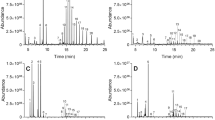Abstract
The Dufour gland ofCrematogaster scutellaris stores a mixture of long-chain primary acetates bearing a cross-conjugated dienone (Scheme 1, la-c). The poison gland contains two highly active enzymes: an acetate esterase and an alcohol oxidase. During venom emission, the constituents of both glands mix and accumulate on the sting, where the formation of the highly electrophilic aldehydes (Scheme 1, 2a-c) from their acetate precursors is initiated. Acetic acid, produced during the reaction, acts as alarm pheromone. The toxicity of the acetates (Scheme 1, la-c) and of the crude secretion has been assessed by topical application onMyrmica rubra. The acetatecontaining secretion from the Dufour gland was less toxic than the enzymatically altered secretion that was rich in aldehydes. The production of acids (Scheme 1, 3a-c) was an artifact resulting from the nonenzymatic oxidation of the unstable aldehydes.
Similar content being viewed by others
References
Aldrich, J.R., Blum, M.S., Hefetz, A., Fales, H.M., Lloyd, H.A., andRoller, P. 1978. Proteins in a nonvenomous defensive secretion: Biosynthetic significance.Science 201:452–453.
Attygalle, A.B., andMorgan, E.D. 1984. Chemicals from the glands of ants.Chem. Soc. Rev. 13:245–278.
Blum, M.S., andHermann, H.R. 1978. Venoms and venom apparatuses of the Formicidae, pp. 801–894,in S. Bettini (ed.). Arthropod Venoms. Springer, Berlin.
Boevé, J.L. 1988. Stratégie défensive des larves de nematines (Hymenoptera, Tenthredinidae) vis- à-vis de leurs prédateurs. Thèse de Doctorat, Université libre de Bruxelles.
Buren, W.F. 1958. A review of the species ofCrematogaster, sensu stricto, in North America (Hymenoptera: Formicidae). Part I.J. N.Y. Entomol. Soc. 66:118–134.
Buschinger, A., andMaschwitz, U. 1984. Defensive behavior and defensive mechanisms in ants, pp. 95–150,in H.R. Hermann (ed.). Defensive Mechanisms in Social Insects. Praeger, New York.
Daloze, D., Braekman, J.C., Vanhecke, P., Boevé, J.L., andPasteels, J.M. 1987. Long chain electrophilic contact poisons from the Dufour's gland of the antCrematogaster scutellaris (Hymenoptera, Myrmicinae).Can. J. Chem. 65:432–436.
Eisner, T. 1972. Chemical defense against predation in arthropods, pp. 157–217,in E. Sondheimer and J.B. Simeone (eds.). Chemical Ecology. Academic, New York.
Eisner, T., Eisner, H.E., Hurst, J.J., Kafatos, F.C., andMeinwald, J. 1963. Cyanogenic glandular apparatus of a millipede.Science 139:1218–1220.
Fukui, S., andTanaka, A. 1985. Enzymatic reactions in organic solvents.Endeavour 9:10–17.
Gagnaire, E., andPayo-Subiza, E. 1963. Couplage des protons d'un méthyle à travers cinq liaisons en RMN: Éthers vinyliques hétérocycliques.Bull. Soc. Chim. France 2623–2627.
Hirsch, J.A., andSzur, A.J. 1972. The hydrolysis of α,α'-dimethoxy-hydrofurans.J. Heterocyc. Chem. 9:523–529.
Leuthold, R.H., andSchlunegger, U. 1973. The alarm behaviour from the mandibular gland secretion in the antCrematogaster scutellaris.Insect. Soc. 20:205–214.
Macleod, J.K., Bott, G., andCable, J. 1977. Synthesis of (Z)- and (E)-4-oxooct-2-enal.Aust. J. Chem. 30:2561–2564.
Mahler, H.R., andCordes, E.H. 1969. Biological Chemistry. Harper & Row, New York.
Maschwitz, U. 1975. Old and new chemical weapons in ants, pp. 47–59,in Ch. Noirot, P.E. Howse, and G. Le Masne (eds.). Pheromones and Defensive secretions in Social Insects. Dijon, Université de Dijon.
Morse, D., andMeighen, E. 1984. Detection of pheromone biosynthetic and degrative enzymes in vitro.J. Biol. Chem. 259:475–480.
Morse, D., andMeighen, E. 1986. Pheromone biosynthesis and role of functional groups in pheromone specificity.J. Chem. Ecol. 12:335–351.
Schildknecht, H., Maschwitz, E., andMaschwitz, U. 1968. Die Explosionschemie der Bombardierkäfer (Coleoptera, Carabidae). III Mitt.: Isolierung und Charakterisierung der Explosionskatalysatoren.Z. Naturforsch. 23b:1213–1218.
Schmidt, J.O. 1982. Biochemistry of insect venoms.Annu. Rev. Entomol. 27:339–368.
Schooley, D.L., Kubiak, F.M., andEvans, J. 1985. Capillary gas chromatographic analysis of volatile and nonvolatile organic acids from biological samples as thef-butyldimethylsilyl derivatives.J. Chromatogr. Sci. 23:385–390.
Tanaka, T., Oro, E., Ishihara, M., Yamanaka, S., andTakinami, K. 1981. Enzymatic acyl exchange of triglyceride inn-hexane.Agric. Biol. Chem. 45:2387–2389.
Author information
Authors and Affiliations
Rights and permissions
About this article
Cite this article
Pasteels, J.M., Daloze, D. & Boeve, J.L. Aldehydic contact poisons and alarm pheromone of the antCrematogaster scutellaris (Hymenoptera: Myrmicinae). J Chem Ecol 15, 1501–1511 (1989). https://doi.org/10.1007/BF01012379
Received:
Accepted:
Issue Date:
DOI: https://doi.org/10.1007/BF01012379




